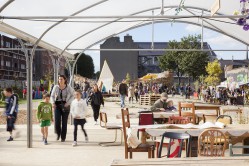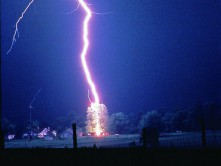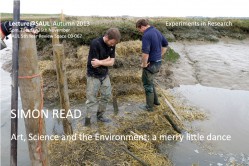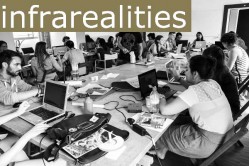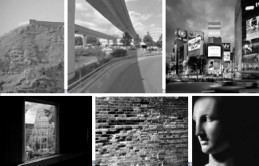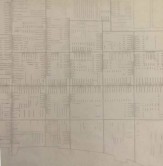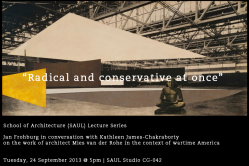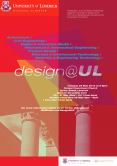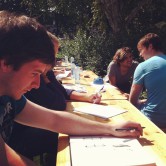140 News
Eco Not Techno: Science Fiction’s (Re)Presentations of Nature by Tom Moylan
18 February 2014 5:00 pm at SAUL Studio
We will begin with looking at science fiction as a modern art form creative that can deliver critical and creative outlooks on the world that generate thought experiments that respond to problems and possibilities in the present day. We will then talk about how we humans think about our relationship with nature, as we work between two extremes wherein the first positions humans as dominant over nature and the second includes humanity as part of nature (although a self-aware part). From there we will review various ways in which science fiction has addressed nature: in terms of eco-disasters or ecocide; of ecotopias; and of the interface between humans and nature.
Tom Moylan is Glucksman Professor Emeritus in the School of Languages, Literature, Culture and the Founder and Co-Director of the Ralahine Centre for Utopian Studies (where he is also one of the editors the Ralahine Utopian Studies Book Series). For the past four years, he has also been an Adjunct Professor in the School of Architecture, teaching a fifth-year elective module on utopian thought and practice; and he has recently worked as a supervisor in the postgraduate research-through-practice programme at the Burren College of Art and the National University of Ireland-Galway. He is the author of two monographs on utopian and dystopian science fiction (Demand the Impossible: Science Fiction and the Utopian Imagination and Scraps of the Untainted Sky: Science Fiction, Utopia, Dystopia) and numerous essays on utopia, dystopia, theology, pedagogy, and political agency. He is co-editor of Not Yet: Reconsidering Ernst Bloch (with Jamie Owen Daniel), Dark Horizons: Science Fiction and the Dystopian Imagination and Utopia-Method-Vision: The Use Value of Social Dreaming (with Raffaella Baccolini), and Exploring the Utopian Impulse: Essays on Utopian Thought and Practice (with Michael J. Griffin). He has co-edited special issues of Utopian Studies on Ernst Bloch, Fredric Jameson, Irish Utopias, and Utopia and Music. In 2009, he was given the Lifetime Distinguished Scholar Award by the Society for Utopian Studies.
‘Pop-up Park (Dublin) 2013’ by Samuel Bishop / Upstart in discussion with Peter Carroll /A2 Architects
11 February 2014 5:00 pm at SAUL Studio
Granby Park was a temporary park that was built on a vacant site in Dublin’s north inner city in August 2013. It was open for 1 month. It was made from up-cycled, recycled, donated & found materials and was a collaboration between some of the city’s artists, event coordinators, architects, performers and creatives.
Built & co-ordinated completely voluntarily, almost 400 volunteers and 1,100 supporters helped create Granby Park which was visited by 40,000 people. Granby Park demonstrated not only an alternative model to the way that we use vacant sites but also an innovative platform for citizens, local government, local community, business, creative professionals and artists to work together. The city council played a valuable role in providing the site and negotiating legal & bureaucratic hurdles.
The park consisted of a polytunnel education hub space, 30 artist installations, a cafe, a children’s play area, a 300-person palette amiphitheatre, grafitti wall & boules pitch, surrounded by planting and furniture. For one month, Granby Park played host to a multitude of exhibitions, installations, events and community activities.
Samuel Bishop is a founding member of Upstart whose interests lie in enabling creative events in public space. Samuel is also co-ordinator of the nationwide street party with Streetfeast. He builds parks with Upstart. He also runs events with Happenings.
Peter Carroll is SAUL Course Director, Director of A2 Architects () and Treasurer of DoCoMoMo Ireland () A2 Architects along with Sean Harrington Architects collaborated with Upstart on the design and execution of Granby Park last summer.
Architecture in the Biosphere by Irénée Scalbert
28 January 2014 5:00 pm at Room CO-O67, Main University Building, UL
Irénée Scalbert is an architecture critic based in London. He is a Visiting Lecturer at the School of Architecture at the University of Limerick. He was a Visiting Design Critic at Harvard University. He currently holds the Sigfried Giedion chair at the Ecole Nationale Supérieure d’Architecture, Paris-Malaquais.
‘Art, Science and the Environment: a merry little dance’ by Simon Read
26 November 2013 5:00 pm at Room CO-O67, Main University Building, UL
Simon Read is a visual artist who, having practiced within a conventional arts milieu for many years, decided to commit himself to exploring how he might contribute to a more profound understanding of environmental change. He quickly understood that the orthodox mechanisms for promoting art are not capable of fostering this discourse and that he should seek fresh paradigms. For nearly twenty years he has increasingly collaborated with communities, fellow academics and governmental institutions to encourage a sense of societal ownership and responsibility. This has been largely focused upon coastal and estuarine environments, in particular those of East Anglia UK, where he lives and also has intimate knowledge of coastal dynamics through the ownership of a seagoing barge.
Program of public conferences
15 November 2013 8:45 pm at SAUL Studio
Since 2011, i2a istituto internazionale di architettura in Vico Morcote has promoted infrarealities, a program of studies on infrastructure and contemporary urban landscape with the goal of creating management and landscape development tools, to be used by public and private organizations and academic institutions. The area chosen as the perfect case-study is the valley of the Vedeggio, in Ticino.
This program collects the contributions of universities from around the world, developed with their students during residences at i2a in Vico Morcote. They thus take part in the research process and offer the possibility of a critical through via debates and conferences in order to question the program via design experiences from very different backgrounds (often with common objectives).
From Sunday 14 October to Saturday 3 November 2012, three schools will be based in Vico Morcote: SAUL-School of Architecture from the University of Limerick (Ireland), the Master in Urban Vision and Architectural Design of Domus Academy in Milan and the Fakultät für Architektur-Fachhochschule in Köln. In occasion of their stay in Ticino, a program of public conferences will be held at i2a istituto internazionale di architettura (first floor hall, Portich da Sura 18, Vico Morcote, Switzerland):
Monday 15 October, 8.45 pm
Jachen Könz (architect, Lugano). Infrastructure and architecture.
Wednesday 17 October, 8.45 pm
Anna Ryan (lecturer in architecture, SAUL-School of Architecture, University of Limerick). Where the Land meets the Sea.
Friday 19 October, 8.45 pm
Grainne Hassett (Hassett Ducatez Architects, Dublin). Works Matters.
Tuesday 23 October, 8.45 pm
Gianandrea Barreca (Barreca & La Varra, Milan). Fill the city.
Thursday 25 October, 8.45 pm
Enrico Sassi (architect, Lugano). Città Ticino and other research.
Wednesday 31 October, 8.45 pm
Nicole Beier Cabrini and Sandro Cabrini (Beier Cabrini architects, Lugano). Örtliche Identität.
Thursday 1 November, 8.45 pm
Jochen Siegemund, Amandus Sattler, Julian Kruger, Anthony Quodt (Fakultät für Architektur-Fachhochschule Köln). Corporate architecture.
The events will be broadcast via live streaming on www.i2a.ch.
Information
Amanda Prada: communication, public relations, development
i2a istituto internazionale di architettura
Portich da Sura 18 . 6921 Vico Morcote . Switzerland
t 0041 91 996 13 87 . hc.a2i@adarpa . www.i2a.ch
Sorting!the!spatial!: Ways to interpret spatial complexity by Pål Röjgård Harryan
11 November 2013 4:00 pm at SAUL Studio
Pål Röjgård Harryan is an architect and owner of Harryan architecture and design. He is educated in Copenhagen, Denmark in the Royal Danish art academy. He teaches at KTH`s School of Architecture, Stockholm, Sweden where he is responsible for the master st of “Alteration in context”. He combines the practice of architecture with theoretical research and teaching.
The City within the City by Peter Carroll Architect in conversation with Kazys Varnelis, Architecture Historian & Theorist
8 October 2013 5:00 pm at SAUL Y5 Crit Space, Room C0-067, UL
In the context of Limerick’s future, is it possible to consider precise yet speculative construction as opposed to architectural form as a point of entry towards the project of the city?
Is it possible that the construction that results is not only a physical object but is what survives the idea of the city?
Focusing on the precise yet speculative nature of Georgian construction, a number of enquiries will be raised:
- the continuity of the macro construction of the city founds (vaulted ground floor, raised streets, culverted sewers, shared construction technologies) in the context of a speculative, piecemeal procurement of city
- the capacity of this construction to deal with siting, local environmental conditions, availability of materials
- the resilience of this Georgian ‘city within the city’ to this day and what it offers in thinking strategically about Limerick’s future city
- what lies beneath, what is hidden from view.
Peter Carroll is SAUL Course Director, Director in A2 Architects, Treasurer of DoCoMoMo Ireland and Elected Member of RIAI Council.
Kazys Varnelis is a historian and theorist of architecture, specialising in network culture. He is Director of the Network Architecture Lab at Columbia University’s GraduateSchool of Architecture. Kazys is a member of the founding advisory board at SAUL where he currently teaches history and theory of architecture.
‘Radical & Conservative at Once’ by Kathleen James-Chakraborty and Jan Frohburg
24 September 2013 5:00 pm at SAUL Studio
“Radical and conservative at once” – On the work of architect Mies van der Rohe in the context of wartime America.
Kathleen James-Chakraborty is Professor of Art History at UCD. A graduate of YaleUniversity, James-Chakraborty earned her doctorate from the University of Pennsylvania. She has taught at the University of Minnesota, at the University of California Berkeley, where she was Professor of Architecture, and at the Ruhr University Bochum. James-Chakraborty is a historian of early modern and modern architecture. She is an expert on twentieth-century German and American modernism.
Jan Frohburg studied in Weimar, London, Zurich and Chicago and has practiced and taught architecture in Germany, the U.S. and Ireland. His research interests include design education and the spatial expression of Modernity, focusing on spatial concepts characteristic to the works of Mies van der Rohe.
Design@UL
28 May 2013 5:00 pm at Former Franciscan Church, Henry Street Limerick
‘Design@UL’ is an exhibition that brings together a diversity of design work from five undergraduate courses at the University of Limerick.
SAUL Student Success in Concrete Design Competition
23 April 2013 12:00 pm
Five students who have recently completed their fourth year in the School of Architecture have had success at the recently held Concrete Design Competition, including a team who shared overall first place.
The winning entry was submitted by Ray McGreal and Coilin Dorgeain, Jenny Kingston was third overall, with Bozidar Milosevic and David Williams being awarded 2 of the 3 special mentions awarded this year. This is the fifth cycle of the biennial Concrete DesignCompetition which is an international event with five participating nations, organised in Ireland by the Irish Concrete Society. The theme of this years competition was energy and concrete, and as part of their prize, Ray, Coilin and Jenny will represent Ireland at an international symposium on energy and concrete which will be held this year at the end of August in the Netherlands.

